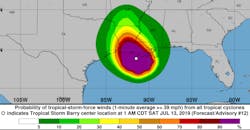Strengthening storm Barry spins toward rain-soaked Louisiana coast
By Brian K. Sullivan
(Bloomberg) — Tropical Storm Barry is expected to come ashore along the Louisiana coast as a hurricane Saturday, bringing a dangerous downpour that could inundate rivers, streets and homes.
As much as 25 inches of rain could fall in some areas, the National Hurricane Center said in an advisory at 5 a.m. in New York. The storm, expected to cause close to $1 billion in damage, may make landfall along the south-central Louisiana coast on Saturday based on its current path. Rainbands of Barry are already beginning to move onshore.
U.S. benchmark West Texas Intermediate crude traded above $60 a barrel on Friday, while natural gas futures capped a third straight weekly gain.
Some other effects of the storm:
- Gulf of Mexico operators have shut-in 1.11 million barrels a day of oil production, the Bureau of Safety and Environmental Enforcement said in a notice. About 1.35 billion cubic feet a day of natural gas production is also halted.
- America’s grain elevators, cotton fields and cane crops in Barry’s path, and almost half of the U.S.’s exports of corn, soybeans and wheat get sent abroad from ports along the Mississippi River.
- The storm is putting 70% of newly minted U.S. LNG capacity at risk, with Cheniere Energy Inc.’s Sabine Pass export terminal and Sempra Energy’s Cameron facility potentially in its path.
- Port Fourchon, a seaport on the Gulf of Mexico serving more than 90% of the region’s deepwater oil production and acting as a land base for Louisiana Offshore Oil Port (LOOP), is under a mandatory evacuation order.
- The storm may have the biggest impact on oil products, with the Louisiana coast home to nearly 40% of U.S. Gulf Coast refining capacity. Royal Dutch Shell Plc’s Norco and Convent refineries are said to be reducing rates on some units and sending nonessential workers home.
- The U.S. Coast Guard expects the New Orleans port to close Friday morning. At least 13 oil ships were waiting in the Gulf of Mexico Thursday, bound for ports that could be affected by the storm.
- Entergy Corp., which runs two nuclear power plants in Louisiana, said it’s keeping a close watch on the storm. Cleco Corp., which supplies power to about 288,000 retail customers in the state, said it’s monitoring Barry and has crews on standby to respond to outages.
- More than 300,000 homes in Louisiana are at risk of flood damage, according to analytics firm CoreLogic.
In addition to Barry, the hurricane center is also tracking a second potential storm in the mid-Atlantic that has a 20% chance of strengthening in the next five days. That system is still “a long, long, long way away,” Walker said.
Additional reporting from Sheela Tobben, Michael Hirtzer, Kevin Varley, Shruti Date Singh, Will Wade, Mark Chediak and Stephen Stapczynski.
